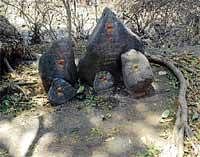

The Holeyas, regarded as untouchables, often dwell outside the village. This unwritten rule is followed scrupulously in many villages across the State to this day. The exception to this rule is Benavara, belonging to Amruthur hobli of Kunigal taluk, where Dalits form the majority population.
The Dalit elders in the village look after their affairs in a fair manner, responsible for all the joys and sorrows of the community. Benavara, with its hundred houses, also has a couple of families each belonging to the upper caste Okkaligas and Akkasaligas (goldsmith). These families have settled in the village to tend to their lands situated close by. However, there is no oppression of the Dalits by the upper castes found in most villages!
The road from Amruthur is asphalted and in good condition. A government lower primary school takes care of the children’s studies along with an anganwadi. The three or four borewells meet the drinking water needs of the people.
Then, there are ten temples in the village. Village deities Arivina Maramma, Pattaladamma, Bettada Thimmappa, Anjaneya, Channakeshava, Maramma, Eshwara, Varadarayaswamy and Doddamma-Chikkamma all dwell in these temples.
The pooja and other rituals for these deities are performed on rote by the five fishermen families of the neighbouring Benavara Koppal. The Lingayat priest of Hanchipur anoints Bettada Thimmappa. The Dalits look after Varadarayaswamy who migrated here, following a devotee of the village, though an idol is yet to be consecrated. Apart from the shrines to Doddamma-Chikkamma, the others are falling apart.
The population numbers 450, of whom there are only a handful of senior citizens while literates can be found in large numbers, some working in Bangalore, Mysore, Tumkur and other cities. Indeed, most of them are employed by the government, the most famous of them being the recently retired deputy conservator of forests B M T Rajeev.
Why only Dalits?
Benavara has had a school since pre-Independence and children of the surrounding villages also attended classes here. The maastikallu, three-four dried-up temple tanks (kalyanis) and other ‘ruins’ indicate that Benavara was once a big town, where people of all castes and professions resided. As such, the village has an interesting story on the absence of the upper castes. It goes thus: The village priest had two beautiful daughters, who were of marriageable age. But it was difficult to find grooms for them from the same caste. Some youths belonging to the upper castes ravished them and the two girls became pregnant.
A horrified priest then prepared a holy site ostensibly to conduct some rituals, after discussing the matter with the Patel of neighbouring Valagerepura. The priest built a stone tomb and asked the sisters to enter it to perform pooja and meditate. As soon as the girls began meditating, their father dragged a stone slab across and entombed them alive!
The priest then cursed the entire village and left Benavara. Soon, the upper caste people were beset with death and other problems. Fearing the priest’s curse to be at work, they left the village with their families while the Dalits remained behind, saying they hadn’t hurt the priest.
A while later, a few Dalit families came from Nagamangala to settle down in the village. The villages belonging to Amruthur hobli, including Benavara presented a barren landscape 50-60 years back. The construction of Markonahalli dam in the 1940s changed the luck of the farmers of the region.
Not everything is hunky-dory between Benavara and surrounding villages. When they were denied entry into the temples of the village deities, the Dalits built the Doddamma, Chikkamma temples.
But there is harmony within the village. Dalits are allowed entry into the headman’s house as well. Says Puttaraju of the Akkasaligas, “Except for eating together, there is no discrimination amongst us and we live like brothers.”
Though Dalits are in greater number, they are yet to succeed in a big way on the financial front. The Markonhahalli dam might have changed the luck of farmers of the region, but there are still families in the village which have five-six acre plots, and are struggling to make ends meet with agriculture.
(Translated by B S Srivani)